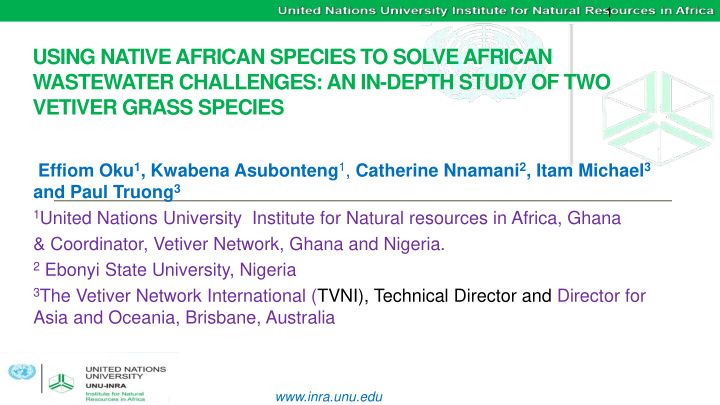



1 USING NATIVE AFRICAN SPECIES TO SOLVE AFRICAN WASTEWATER CHALLENGES: AN IN-DEPTH STUDY OF TWO VETIVER GRASS SPECIES Effiom Oku 1 , Kwabena Asubonteng 1 , Catherine Nnamani 2 , Itam Michael 3 and Paul Truong 3 1 United Nations University Institute for Natural resources in Africa, Ghana & Coordinator, Vetiver Network, Ghana and Nigeria. 2 Ebonyi State University, Nigeria 3 The Vetiver Network International (TVNI), Technical Director and Director for Asia and Oceania, Brisbane, Australia www.inra.unu.edu
United Nations University Institute for Natural Resources in Africa What we kn know and the chall llenges • Wastewater management challenge is a global issue (Plate 1&2) (UNEP, 2010 and Kumar 2011). • Most industrial effluents in Sub Sahara Africa are discharged into environment untreated. Plate 1. Water drainage way in a city in Nigeria • Settling pond popular in wastewater management in Africa (Nikiema et al ., 2013) • Conventional treatment technologies are very limited and climate change is impacting. Plate 2. An urban vegetable farm irrigated using water from Plate 1 . 2
United Nations University Institute for Natural Resources in Africa What we know and the challenge • South Indian spp is effective in wastewater treatment (Truong and Hart, 2001; Truong, et al ., 2006) • Three spp of vetiver grass are known (Truong et al ., 2006). • All known spp of vetiver have different A potentials, some for erosion control as in plate 3. (Truong et al ., 2008). B • Use of vetiver in Africa is not common and still at its infancy (Babalola, et al ., Plate 3 shows Chrysopogon 2007: Oku, 2011 ). zizanioides (A) and Chrysopogon nemoralis (B) (Source:www.vetiver.org ) 3
United Nations University Institute for Natural Resources in Africa What we d do not know • The effectiveness of African spp in removing contaminants in wastewater. Objective • To study the effectiveness of African spp in wastewater treatment and compare with well known South Indian spp . 4
United Nations University Institute for Natural Resources in Africa Methodology • Effluents collected from quarry site, fertilizer company and untreated public dump site. • Vetiver raised hydroponically for root and shoot establishment. • Floating raft with established vetiver 4A 4B immersed in effluents as in Plate 4 Plate 4 Set-up with South Indian spp (Truong et al ., 2008). (4A) and African spp (4B) floating in effluent from fertilizer company. 5
United Nations University Institute for Natural Resources in Africa Methodology • Pre-and post-treatment contaminants determined included, heavy metals, pH, BOD, COD (FEPA,1991; APHA, 2001; WHO, 1989; and Udo et al ., 2011). • Treated effluents collected after 2, 4 and 6 days for laboratory analysis. • Contaminant levels compared with safe levels by FAO/WHO. 6
United Nations University Institute for Natural Resources in Africa Results and Discussion 100% 120 Nitrate in leachate (mg l -1 ) African spp 100 South Indian spp 80 55% 55% 58% 59% 59% 60 63% 40 20 0 PTL 2DAT 4DAT 6DAT PTL = pre-treatment, contaminant levels, DAT = days after treatment; AL = allowable limit Fig 1: Pre level and post-treatment, nitrate removal rate in public dump untreated leachate in Abakaliki, Nigeria. 7
United Nations University Institute for Natural Resources in Africa 100% 100 Phosphate in leachate (mg l -1 ) 90 80 African spp South Indian spp 70 43% 60 50% 55% 50 56% 40 72% 30 79% 20 10 0 PTL 2DAT 4DAT 6DAT PTL = pre-treatment, contaminant levels, DAT = days after treatment; AL = allowable limit Fig 2: Pre-level and post-treatment phosphate removal rate in public dump untreated leachate in Abakaliki, Nigeria. 8
United Nations University Institute for Natural Resources in Africa 0.2 Cadmium in ferilizer 0.18 effluent (mg l -1 ) African spp 0.16 South Indian spp 0.14 0.12 0.1 0.08 0.06 0.04 0.02 0 PTL 2DAT 4DAT 6DAT PTL = pre-treatment, contaminant levels, DAT = days after treatment; AL = allowable limit Fig 3: Pre level and post-treatment, Cd removal rate in fertilizer industry effluent in Abakaliki, Nigeria. 9
United Nations University Institute for Natural Resources in Africa pH of quarry effluent (mg l -1 ) 14 African spp South Indian spp 12 10 8 6 4 2 0 PTL 2DAT 4DAT 6DAT PTL = pre-treatment, contaminant levels, DAT = days after treatment; AL = allowable limit Fig 4: Pre and post-treatment, pH levels in quarry effluent collected in a city in Abakaliki, Nigeria . 10
United Nations University Institute for Natural Resources in Africa 100% Lead in quarry effluent (mg l -1 ) 0.3 African spp 0.25 South Indian spp 0.2 0.15 13% 0.1 80% 83% 83% 0.05 77% 97% 0 PTL 2DAT 4DAT 6DAT PTL = pre-treatment, contaminant levels, DAT = days after treatment; AL = allowable limit Fig 5: Pre and post-treatment, Pb levels in quarry effluent in Abakaliki, Nigeria. 11
United Nations University Institute for Natural Resources in Africa Conclusion • African spp of vetiver grass is as good as South Indian spp . • African spp was more effective in removing phosphate while, South Indian spp was more effective on nitrate. • Both spp improved pH. • Both spp should be combined where possible for maximum industrial benefit. • Africa can rely on its endemic spp for commercial and micro scale wastewater treatment. • Production of hybrid of the two spp is needed. 12
United Nations University Institute for Natural Resources in Africa Acknowledgement First author acknowledges the African Women in Agricultural Research and Development (AWARD) for partly sponsoring this trip to enable him present this paper at this conference. 13
Thank you Questions!!! www.inra.unu.edu 14
Recommend
More recommend